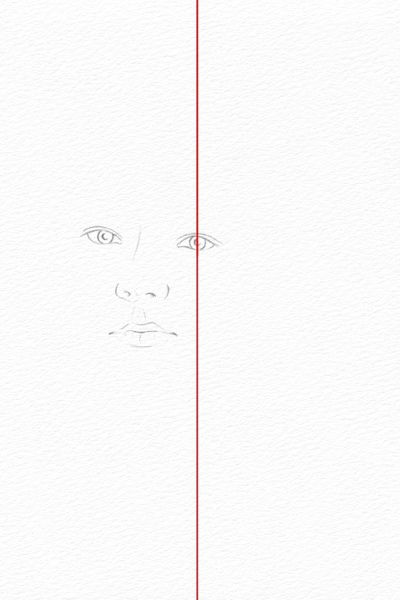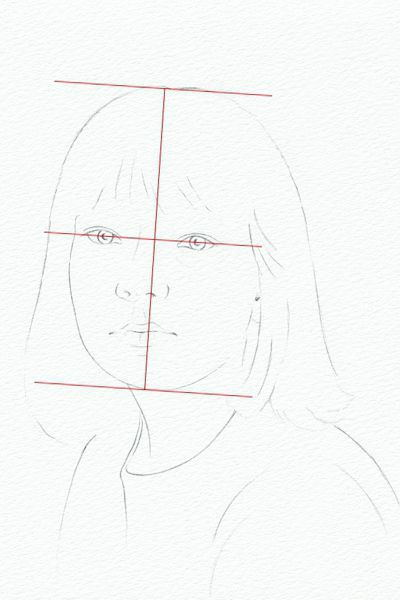PENCIL PORTRAIT OF A YOUNG GIRL
(2B pencil on paper)
(2B pencil on paper)
Our Pencil Portrait lesson explains and illustrates the step by step drawing techniques involved in creating the above portrait of a young girl.
The general proportions of a head that we outlined on previous pages are ideal for drawing realistic heads from your imagination. They are also a good reference if you feel that you are making major errors in your portraits.
However, when you draw a portrait from life, a more accurate approach to drawing is needed. You need to record the subtle variations of the features which make that individual's face unique. Such an approach was used to build our pencil portrait above.
There are three basic stages in the creation of this image:
1. Using line drawing to organise the position, shape and proportion of the features.
2. Using softly shaded tone to create the form and texture of each feature.
3. Refining the tone to unite all the elements of the portrait.
The general proportions of a head that we outlined on previous pages are ideal for drawing realistic heads from your imagination. They are also a good reference if you feel that you are making major errors in your portraits.
However, when you draw a portrait from life, a more accurate approach to drawing is needed. You need to record the subtle variations of the features which make that individual's face unique. Such an approach was used to build our pencil portrait above.
There are three basic stages in the creation of this image:
1. Using line drawing to organise the position, shape and proportion of the features.
2. Using softly shaded tone to create the form and texture of each feature.
3. Refining the tone to unite all the elements of the portrait.

Step 1a - Positioning the Basic Features
Most artists make the greatest number of changes at the start of a drawing. Therefore it is important to draw lightly at first, as lightly drawn lines are easier to erase.
You begin a portrait with the eyes as they are the main focal point. Take care where you choose to position them on the page as this will affect the overall balance of the portrait. In the image above and you will see that right eye is situated on the vertical centre of the page. This is a strong compositional starting point for a three quarter view portrait.
The size and position of the other features are directly related to the scale and placement of the eyes.
If you get the correct relationship between the eyes, nose and mouth, you will end up with a good likeness.
You begin a portrait with the eyes as they are the main focal point. Take care where you choose to position them on the page as this will affect the overall balance of the portrait. In the image above and you will see that right eye is situated on the vertical centre of the page. This is a strong compositional starting point for a three quarter view portrait.
The size and position of the other features are directly related to the scale and placement of the eyes.
If you get the correct relationship between the eyes, nose and mouth, you will end up with a good likeness.

Step 1b - Building the Outline of the Portrait
The next step is discover the size of the head by establishing the distances between the eyes and the top of the head and the eyes and the chin. Note that these measurements should be similar.
The main features are then framed by the outline of the face and hair, while the neck and shoulders form an angular support for the head. The hairline on the right side of the face creates a sweeping curve which meets the neckline of the T-shirt. This movement builds a strong visual link between the head and shoulders.
At this stage, the drawing is no more than a set of carefully measured features that establish the final proportions of the head.
The main features are then framed by the outline of the face and hair, while the neck and shoulders form an angular support for the head. The hairline on the right side of the face creates a sweeping curve which meets the neckline of the T-shirt. This movement builds a strong visual link between the head and shoulders.
At this stage, the drawing is no more than a set of carefully measured features that establish the final proportions of the head.

Step 1c - Building up the Detail in Line
The final stage of the line drawing in this portrait is to sketch some of the detail in the hair and the folds on the T-shirt.
The lines of detail in the hair should follow the direction and shape of the locks as they split into different strands. They should be drawn quickly and forcefully to give a natural rhythm and vitality to the shape of the hair.
The folds in the T-shirt help to emphasise the form and angle of the shoulders. They should be gentle and uncomplicated curves that do not distract your attention from the rest of the portrait.
The lines of detail in the hair should follow the direction and shape of the locks as they split into different strands. They should be drawn quickly and forcefully to give a natural rhythm and vitality to the shape of the hair.
The folds in the T-shirt help to emphasise the form and angle of the shoulders. They should be gentle and uncomplicated curves that do not distract your attention from the rest of the portrait.


0 Comments:
Post a Comment